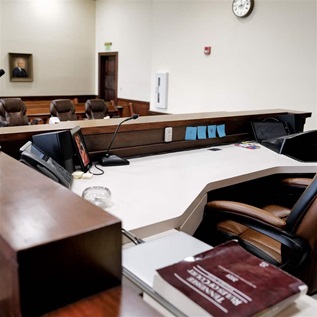Nation's Leading Judicial Organizations Partner to Improve Foster Care, Eliminate Court Delays Which Sentence Children to Foster Care Drift
A groundbreaking new curriculum developed by the nation's leading judicial organizations identifies court delays as a key factor that prolongs children's time in foster care. Released today at an event sponsored by the national, nonpartisan Fostering Results at the Washington, D.C. Family Court, the National Curriculum reveals that “despite many efforts, children remain too long in foster care during the time that their cases are pending in court.”
The National Curriculum for Caseflow Management in Juvenile Dependency Cases Involving Foster Care was inspired by a desire to recognize and eliminate the delays that often plague child welfare cases. These delays –caused by everything from insufficient information collection, to postponement of hearings because all parties are not present, to miscommunication between parties – can result in children lingering in foster care “limbo,” drifting from foster home to foster home without achieving safety and permanence.
“As a former judge, I am all too aware of the adverse effects of these delays on children in foster care,” said Nancy Salyers, co-director of Fostering Results and former Presiding Judge of the Cook County (IL) Juvenile Court's Child Protection Division. “Children and families pay the price when courts lack needed tools and resources.”
Leading national judicial organizations partnered to create the curriculum, including: The ABA Center on Children and the Law, American Public Human Services Association, Arizona Administrative Office of the Courts, Conference of State Court Administrators, Fostering Results, The Judicial Education Reference, Information and Technical Transfer Project, The Justice Management Institute, National Center for State Courts, National Council of Juvenile and Family Court Judges, National Association of Council for Children, New York Administrative Office of the Courts, the Ohio Administrative Office of the Courts and the Texas Office of Court Administration.
“The goal of the National Curriculum is to improve the court system's ability to oversee the movement of foster care cases to shorten the time needed for children to reach permanent placement,” stated Douglas Somerlot, executive vice president of the The Justice Management Institute and Curriculum co-author.
The curriculum emphasizes the need for state courts and child welfare agencies to work together to improve outcomes for children. It is designed to foster collaboration between these key entities.
“The curriculum is a readily available proven method for teaming court and agency personnel so that they can work together to identify shared goals, areas of delay and then devise a specific strategy for collaboration that will work in their community,” stated Maureen Conner, executive director of the Judicial Education Reference, Information and Technical Transfer Project.
“Ensuring safe, timely permanency for children in foster care depends on the collection and sharing of sufficient and reliable information so that judges can make the best and most informed decisions for the children before them,” stated Anita Light, director of the National Association of Public Child Welfare Administrators, American Public Human Services Association.
Child welfare agencies' personnel and judges are the “gatekeepers” of the foster care system and must work together to ensure improved outcomes for children in care.
“Courts and child welfare agencies share responsibility for protecting children and mending families. Without active collaboration between the two, both can be hindered in fulfilling these critical responsibilities,” cautioned Howard Davidson, director of the ABA Center on Children and the Law. The ABA Center on Children and the Law and Fostering Results issued Improving Outcomes Together, a companion to the curriculum which includes real-life examples of successful collaboration in states including Florida, Ohio, Minnesota, California, Kentucky, Utah, Washington, Arizona, Kansas, Massachusetts and others. The paper was authored by Cecilia Fiermonte of the ABA Center and Nancy Salyers of Fostering Results.
Development of the curriculum was funded by The Pew Charitable Trusts as a part of its commitment to advancing policy solutions to ensure children do not languish in foster care. “This new innovative curriculum reflects many of the nation's leading judicial organizations resolve to remedying delays in the courts that oversee foster care cases,” said Maureen K. Byrnes, director, Policy Initiatives and the Health and Human Services Program at The Pew Charitable Trusts. “It builds on the recommendations of the Pew Commission on Children in Foster Care and provides useful guidance to decision makers in helping children move from foster care to safe, permanent homes in a timely manner.”
Said Mary Mentaberry, executive director of the National Council for Juvenile and Family Court Judges, “Collaboration can result in real change for children in terms of the amount of time they spend in foster care. The National Curriculum can be a first step in helping effect this change and improve the lives of children in foster care.”
About Fostering Results
Fostering Results is a national, nonpartisan public education project to raise awareness of issues facing children in foster care. It is supported by a grant from The Pew Charitable Trusts to the Children and Family Research Center at the School of Social Work, University of Illinois at Urbana-Champaign. For more information, please visit: http://www.fosteringresults.org. To download the National Curriculum, please visit The Judicial Education Reference, Information and Technical Transfer (JERITT) Project's Web site.






